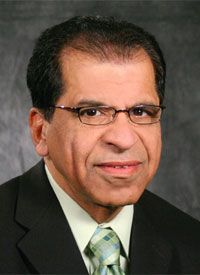Atezolizumab Continues To Show Potential in NSCLC
With atezolizumab (MPDL3280A) showing great potential as a treatment for patients with non
Atezolizumab NSCLC

Chandra P. Belani, MD
With atezolizumab (MPDL3280A) showing great potential as a treatment for patients with nonsmall cell lung cancer (NSCLC) in two particlar studies, we sat down with Chandra P. Belani, MD, to talk more about the treatment.
The PD-L1 inhibitor received a breakthrough therapy designation from the FDA based on early-stage studies as a potential treatment for patients with PD-L1positive NSCLC, post-progression on prior therapies such as chemotherapy and targeted therapies. Belani, Miriam Beckner Distinguished Professor of Medicine, Penn State Milton S. Hershey Medical Center, deputy director, Penn State Hershey Cancer Institute, said in an interview withTargeted Oncology, that the acitivity the treatment shows is impressive.
"One study that I felt was impressive looked at atezolizumab with chemotherapy. It investigated the agent with 3 different regimens: carboplatin and paclitaxel, carboplatin and nab-paclitaxel, and carboplatin and pemetrexed. There was an almost 100% disease control rate in patients who had any expression of PD-L1," he said. "That is impressive data. The numbers in the trial were small, but the results suggested that combining atezolizumab with chemotherapy might actually bring out those provocative responses in NSCLC."
In the phase II BIRCH trial, over 61% of responses were ongoing after a minimum follow-up of 6 months in patients with stage IIIB/IV or recurrent NSCLC who received atezolizumab. The phase II POPLAR study, which compared atezolizumab with docetaxel, found that patients with the highest level of PD-L1 expression experienced a median overall survival (OS) with atezolizumab of 15.5 months versus 11.1 months with docetaxel (HR, 0.49; 95% CI, 0.22-1.07; P = .068).
Belani explained that atezolizumab targets PD-L1 and the ligand B7.1, but does not bind to PD-L2. He adds that the treatment may result in less lung toxicity compared with PD-1 inhibitors, as there is some evidence that combining PD-1 and PD-L2 leads to increased toxicity.
Atezolizumab has also shown significant promise as part of a combination regimen.
"Phase III clinical trials are in progress where atezolizumab is being compared to chemotherapy as a single agent or combined with chemotherapy and then compared to chemotherapy alone. There are 4 large phase III studies in progress and they will be let out in 2017," said Belani.
In an ongoing clinical trial studying atezolizumab, 63.4% of evaluable patients who received atezolizumab with 1 of 4 chemotherapy regimens had an objective response.
Among the various chemotherapy regimen groups, the greatest response was seen in the arm that received the combination of atezolizumab, carboplatin, and pemetrexed, which showed a 77% response rate. Four patients who were treated with atezolizumab, carboplatin, and nab-paclitaxel also had complete responses. Belani says this could indicate that PD-L1 is an effective biomarker.
"I think that we are seeing a lot of interest in this. The activity seems to be based on PD-L1 expression. However, I think we will have to better study the tumors and patients to actually say this is a predictive and prognostic biomarker for treatment with these immunotherapeutic agents," he said.
"There are dynamic changes that occur in PD-L1 expression if patients are treated with a driver drug that have a driver mutation, which might actually be disappearance of the PD-L1 expression. There may be appearance of PD-L1 expression after chemotherapy, because chemotherapy is known to increase that immune infiltrate and cause immunomodulation. There may be sequential administration of chemotherapy with PD-L1 targeted agents such as atezolizumab."
Roundtable Roundup: Lung Cancer Molecular Testing and ALK-Targeted Treatment
January 18th 2025In separate, live virtual events, Vincent K. Lam, MD, and Chul Kim, MD, MPH, discuss molecular assays and treatment options for a patient with metastatic non–small cell lung cancer (NSCLC), with participants.
Read More
Amivantamab/Lazertinib Maintains OS Benefit in EGFR+ NSCLC
January 15th 2025During a Case-Based Roundtable® event, Joshua K. Sabari, MD, continued discussion of key outcomes from the MARIPOSA trial and toxicity management in patients with EGFR-mutated non–small cell lung cancer in the second article of a 2-part series.
Read More